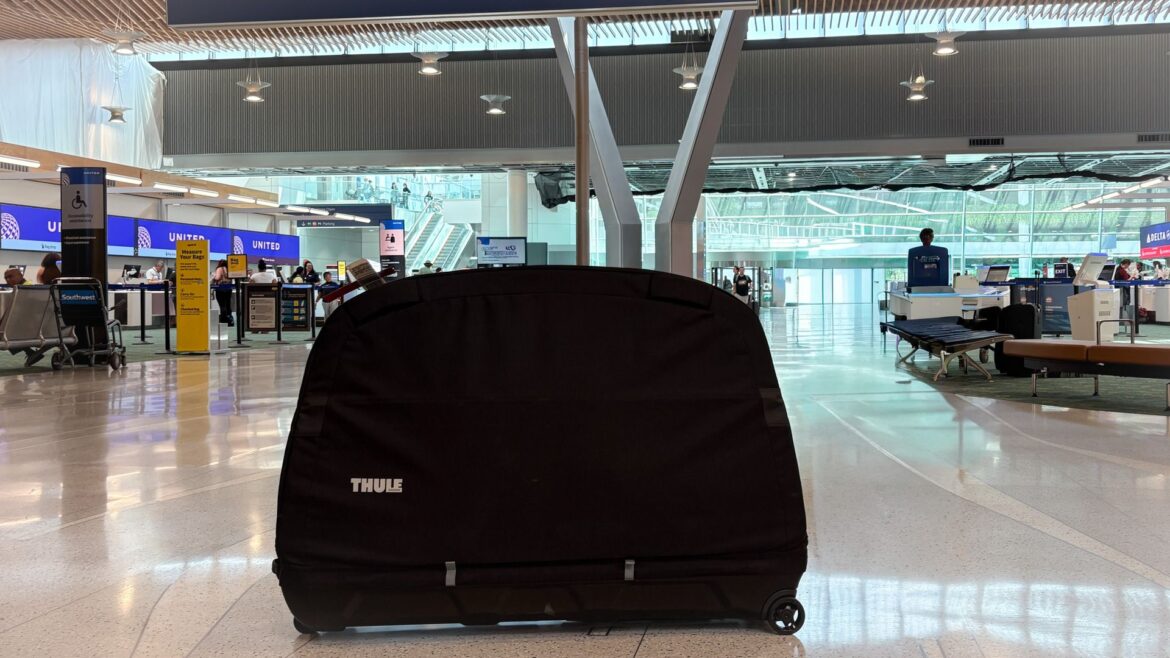Thule has been in the travelling-with-gear game for a while now. Founded in Sweden in 1942, the company built its reputation on clever, durable ways to move the things people love most: skis, kayaks, bikes, even dogs and children. It launched its first roof-rack ski carrier back in 1962 and entered the bike-carrying market three decades later with a tow-bar-mounted rack in 1992. Fast-forward to 2014, and Thule unveiled its first dedicated bike travel case: the RoundTrip. It quickly earned a loyal following for its defining feature: the integrated work stand.
The bike’s fork and bottom bracket attach to a sturdy metal rail that clips securely into the bag itself, keeping everything anchored during travel. Once you arrive, the base and frame lift out together, slot onto the included tripod, and just like that, you’ve got a full-size, functional work stand ready for bike reassembly or a quick tune-up.
And while there have been several iterations of the RoundTrip over the years, that defining feature hasn’t changed much. It’s still what makes this case stand out. The question is: is it enough to justify the $1,000 price tag? And, most importantly, would I entrust the RoundTrip with my beloved bike?
After four flights, I can give a resounding “yes” to trusting the bag, though the very feature that makes it so distinctive ended up being left behind — literally. Let’s dive in.
The Thule Roundtrip
Packed up, the Roundtrip makes for a sleek and secure package.
(Image credit: Anne-Marije Rook)
The Thule RoundTrip travel case is built around a simple promise to give bike travellers peace of mind. At its core, it’s a hybrid solution; more padding and rigidity than a lightweight soft case like a Dakine Bike Roller Bag or Orucase Ninja Bag, but far more manageable, and with a smaller footprint than a full-on hard shell.
Rigid side panels reinforced with 5mm corrugated polypropylene attach to a moulded HDPE base tub, where a metal rail carrying your bike sits securely clipped in. Inside, you’ll find large padded panels that wrap around the entire bike frame, secure mounting points, designated rotor pockets, and thoughtfully designed sleeves for components.
The exterior is clad in bluesign®-certified 600D polyester and tarpaulin fabrics, and three large wheels allow for easy transport.
The bag’s defining feature, the integrated work stand, consists of a rail (which doubles as a harness to hold the bike frame in place during transport), a base and a trio of legs — all of which have dedicated storage slots within the case.
The latest Roundtrip model supports wheelbases up to 110cm and all common front-axle formats, from 9mm quick-release skewers to 12 × 100mm thru-axles and 15 × 110mm Boost spacing. Refinements include tailored storage pockets, a smooth zipper path and collapsible sidewalls for easier storage, plus a removable swivel wheel with a designated stowage spot inside the case for transit.
Specs and Key Features

The Roundtrip’s defining feature: the integrated work stand.
(Image credit: Anne-Marije Rook)
- Supports bikes with a wheelbase up to 110cm
- Includes a removable work stand
- Outside consists of rigid side panels reinforced with 5mm corrugated polypropylen and a moulded HDPE bottom tub
- The bike fastens to the work stand inside the case for secure transport
- Padded interior panels and secure mounting points ensure that everything remains perfectly in place, even after security screening
- The case collapses for compact storage measuring 124 x 38 x 24cm
- Swivelling front wheel for manoeuvrability can be removed for the flight
- Brake rotor pockets locate wheels in the optimal packing position and protect rotors from bending
- Tailored packing to protect the handlebar, seat, seat post and drivetrain
- Work stand fits all front axle sizes, including 15×110 boost, 15×100, 20×110, 12×100, 9mm quick release
- Weight: 27.63 lb
- Retail price: $999.95
The Roundtrip in use

The Thule Roundtrip on its second trip
(Image credit: Anne-Marije Rook)
In the last few months, I entrusted the Roundtrip to carry my Specialized S-Works Crux gravel bike safely on four flights.
For reference, I’ve used a range of bags over the years, from the flat-lying black hard plastic boxes to the Scicon Aerocomfort, the Dakine soft case, and various iterations of the highly compact Orucase cases.
There’s something good and bad to say about each of them. You’re always compromising on some aspect, be it ease of packing or size, transportability or security. There’s a downside to the Roundtrip, too, but fortunately, it’s got little to do with how well it protects your bike.
Packing the Roundtrip
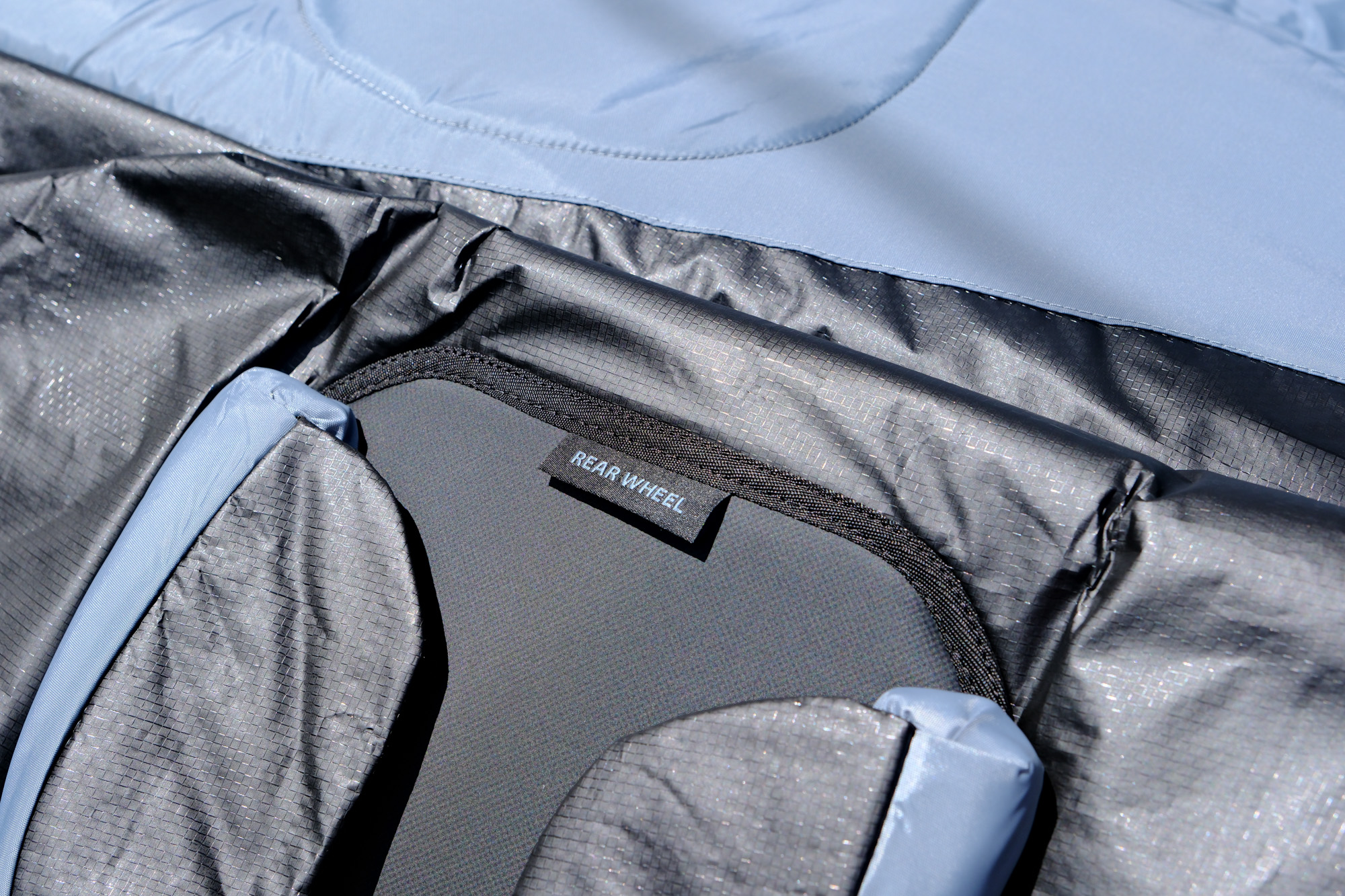
The RoundTrip is a meticulously designed bag. There’s a well-padded, dedicated slot or sleeve for every component.
(Image credit: Anne-Marije Rook)
The RoundTrip is a meticulously designed bag. There’s a well-padded, dedicated slot or sleeve for every component, and once everything is in place, it all sits impressively secure. That matters more than most people realise: it’s not necessarily impact but movement that usually causes damage in transit, and here, nothing shifts.
Packing the bike is also surprisingly quick. There’s a QR code inside the bag that links to an instructional video, but after one go, you won’t really need it; the process is remarkably intuitive.
It starts with assembling the workstand: slot the three legs into the base, attach the tray, and mount your bike by removing the wheels and securing the frame via the thru-axle mounts and bottom-bracket strap.
Next, remove the bars (either with or without the stem) and fasten them into the tailor-made padded sleeve that doubles as frame protection. The rear derailleur and seatpost each get their own protection sleeves as well, keeping components well isolated from one another and secured inside the bag.
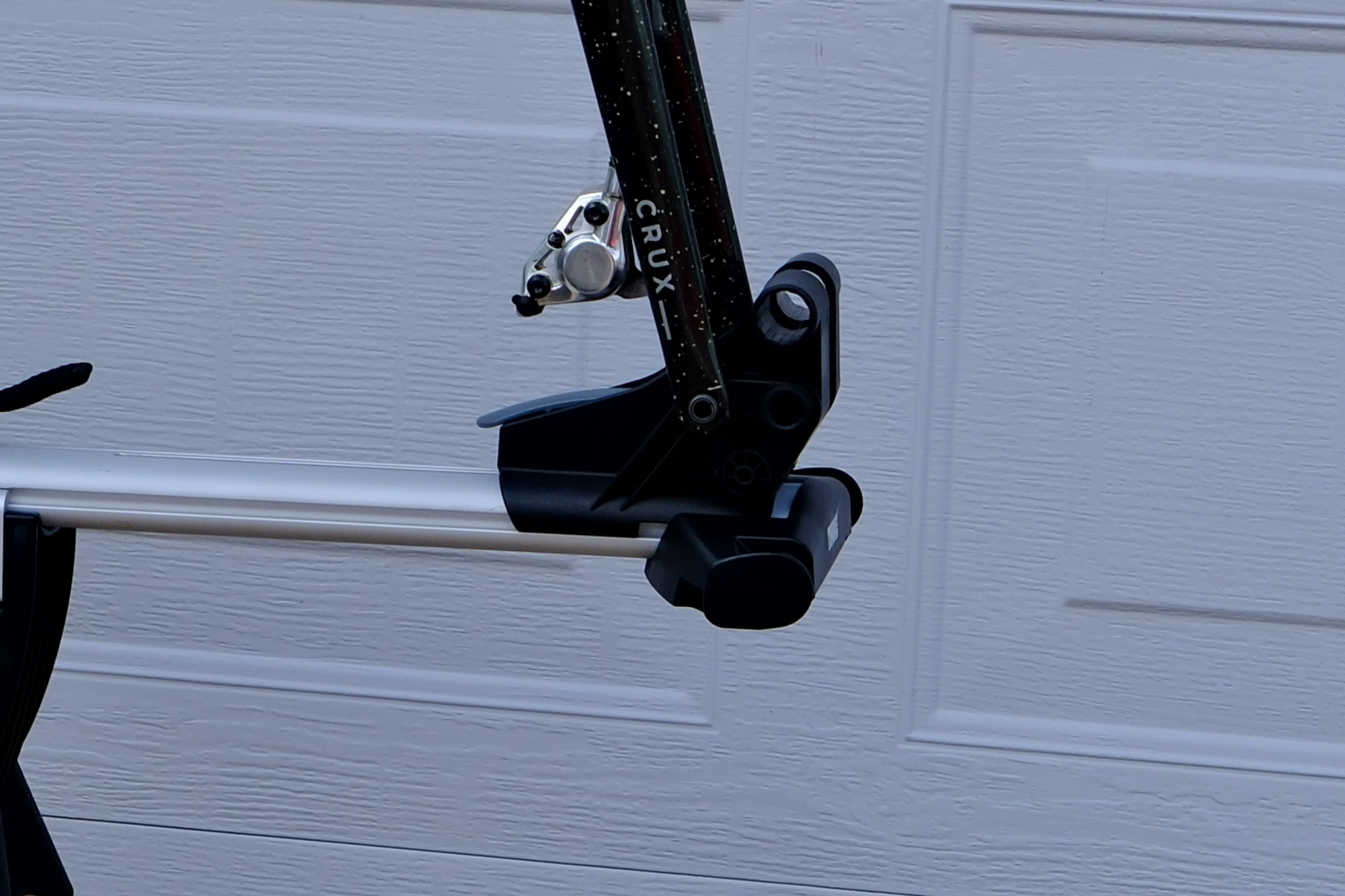
Work stand fits all front axle sizes, including 15×110 boost, 15×100, 20×110, 12×100, 9mm quick release
(Image credit: Anne-Marije Rook)
Once the bike is secure, unclip the tray from its base and click it into the bottom of the bag. The work stand’s base gets reattached to the tray once inside the bag, and the legs slide into the designated slots on the interior flaps.
These two large, padded inner flaps fold over to encase the bike entirely. The wheels slot into the outside of these flaps into the padded rotor pockets, and held in place by Velcro straps.
Zip it up and off you roll. The result is a sleek and secure package. Nothing rattles, nothing rubs, and everything is cocooned in padding thick enough to inspire confidence.
Mobility
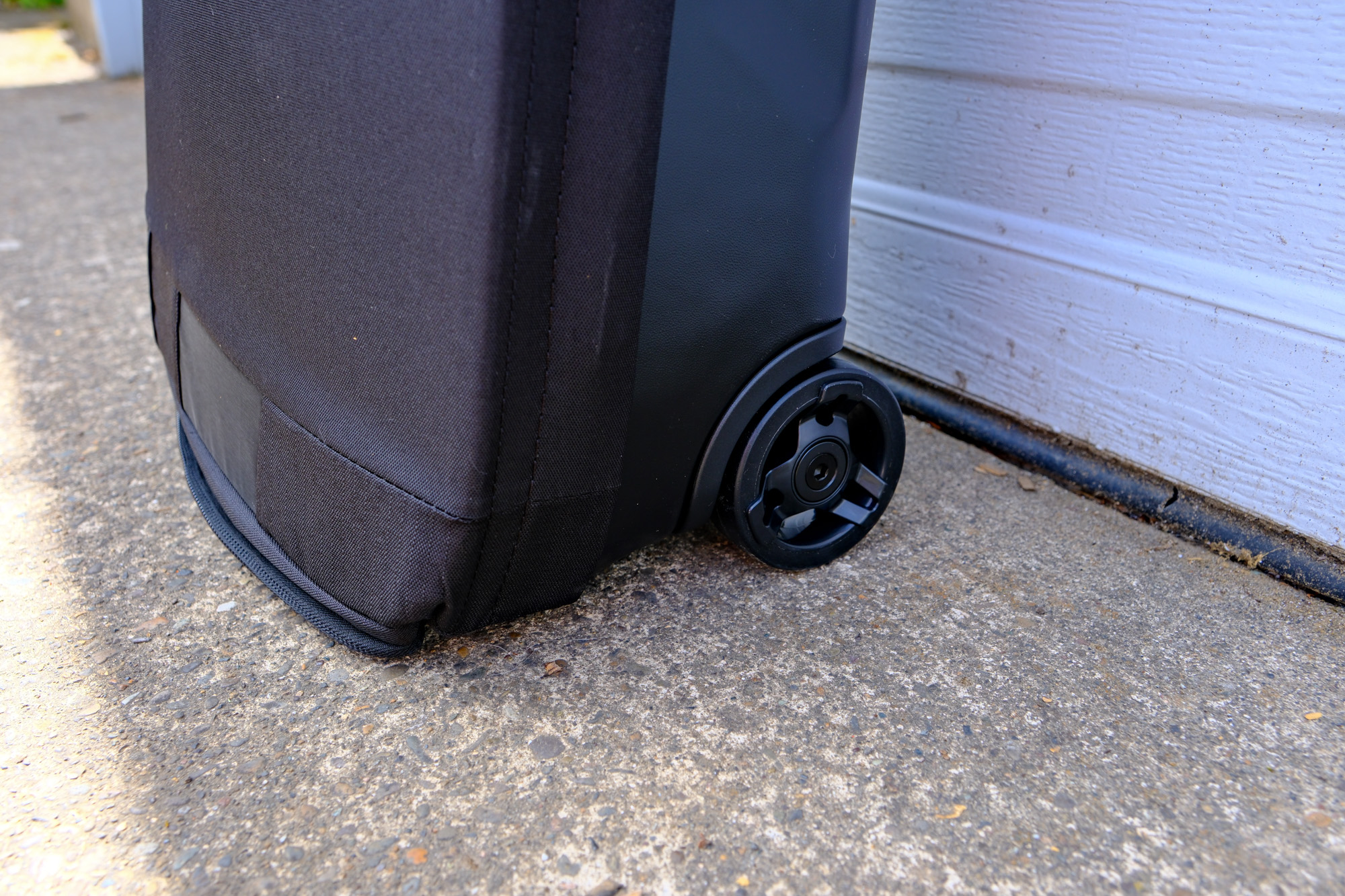
The bag has three study wheels, including a removable front swivel wheel that stows away inside the bag for easier loading and unloading.
(Image credit: Anne-Marije Rook)
The bag has three study wheels, including a removable front swivel wheel that stows away inside the bag for easier loading and unloading.
In a straight line, the bag rolls well and feels stable, but it’s less graceful in tight spaces. The turning radius is wide enough to make elevator rides or train platforms a bit of a dance, and sharp manoeuvres often require a three-point turn.
I found it behaved a bit like a finicky shopping cart: it has a preferred direction, and if you try to drag it sideways or over awkward curbs, it fights you.
At the airport
At the airport, I discovered both the highlights and the major downside of the Roundtip bag.
The latter being that the bag is heavy. Even unloaded, it weighs 28 pounds, meaning you’ll reach the 50-pound airline threshold rather quickly. Even with my featherweight bike, I ended up having to leave the stand’s base and legs at home or risk paying overage fees. Disappointing, because the stand is one of the big selling features of the Roundtrip.
Yet one of the bag’s strong suits is its layout. The inner flaps make the interior of the bag easily accessible both for you, the user, and airport security. The agents can unzip the bag, unfold the flaps and inspect what they need, and close it again without disassembling any part of your careful packing job.
As someone who once had a bike bag returned half-zipped, taped together, with individual components scattered across the baggage carousel, this accessibility alone significantly reduces the anxiety of flying with a bike.
After four flights, my bike arrived perfectly unscathed each time. No additional frame scuffs, no bent rotors, no damage whatsoever. The bag’s contents in the exact place where I had packed them.
Thanks to its TSA accessibility, hard base tub, rigid side panels and secure placements for the contents, I felt significantly less nervous than I usually do when flying with my bike.
Storage
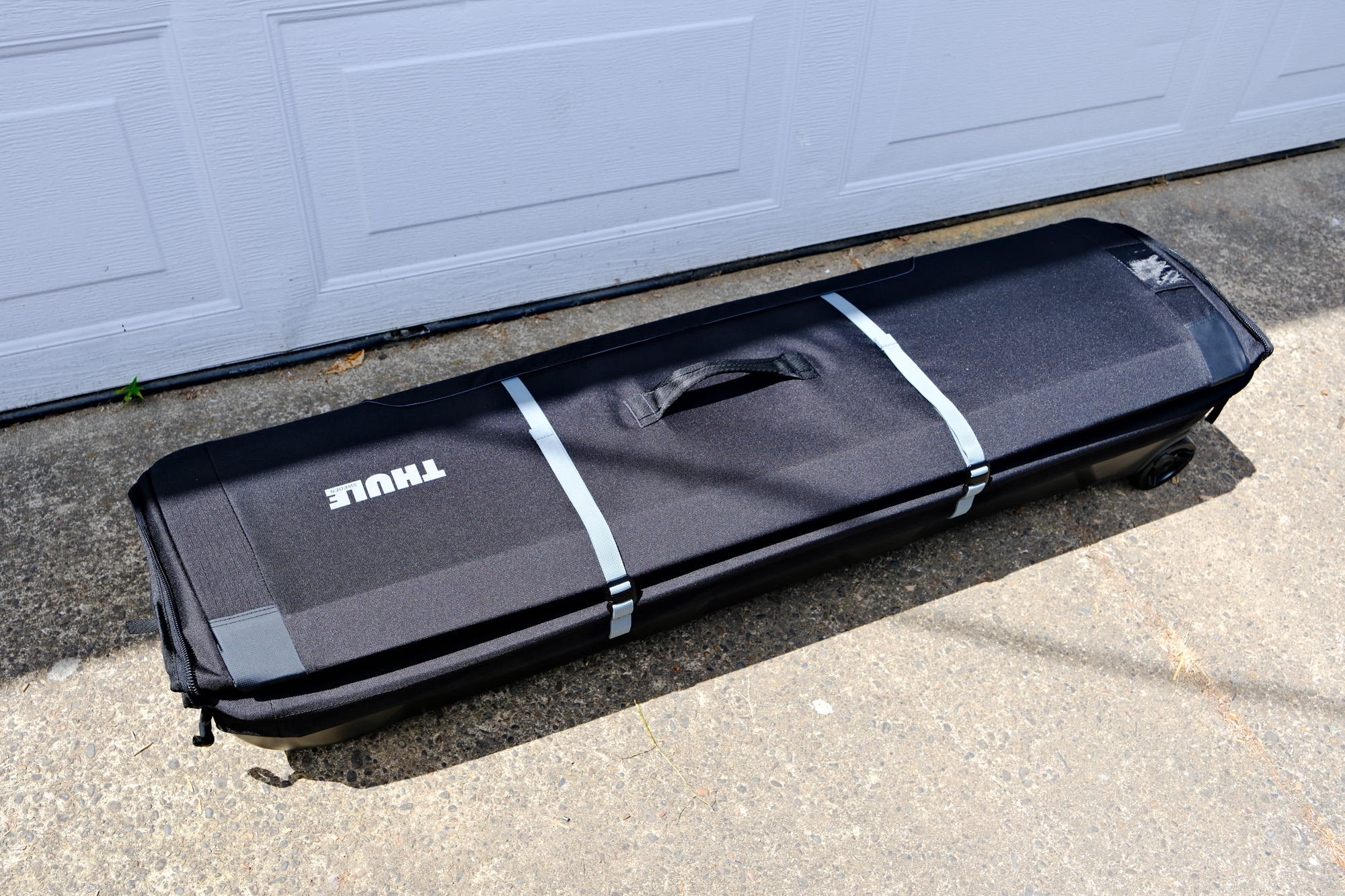
(Image credit: Anne-Marije Rook)
When not in transit, the ability to collapse the bag’s sidewalls is a plus. It’s still bulky, but it would fit pretty easily underneath your bed.
Value & Verdict

(Image credit: Thule)
At roughly $1,000, the Thule RoundTrip sits firmly at the premium end of the bike travel market; almost double of what you can get the market-leading Scicon Aerocomfort for these days. But if you’re a frequent traveller, the RoundTrip may well justify the investment with its exceptional build quality and thoughtful design. Packing is straightforward, and the internal layout is so orderly that even airport security can get in and out without disturbing a thing.
Most importantly, after four flights with a Specialized S-Works Crux inside, the bag performed flawlessly. My bike arrived unscathed every time, and reassembly at the destination took all of fifteen minutes. It’s about as close to stress-free as flying with a bike can get. I really can’t fault the RoundTrip’s ability to deliver your bike safely and with minimal hassle.
However, using it to its full potential does come at a cost. The RoundTrip’s defining feature, its integrated work stand, is also the reason why it reaches that 50 lb airline weight limit so quickly. Rather than pay overage fees, I often left the stand’s base and tripod legs at home, which rather defeats the purpose of having it in the first place. Still, for riders who travel regularly with high-end bikes and value peace of mind over baggage fees, the RoundTrip remains one of the most confidence-inspiring hybrid cases I’ve used.
